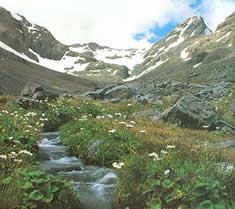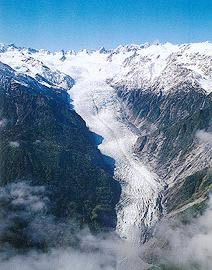
In the heart of the Southern Alps, Arthur's
Pass National Park has an incredible diversity of flora and landscape.
They range from eastern beech clad hills and tussock valleys to the luxuriant
rain forest in the west. Highway 73 runs through the park, giving easy access
to the alpine zone. The highest mountains have glaciers and surrounding
them are tussock basins, flowering herbs and alpine grasses.
Craigieburn Conservation Park is a small mountainous
park adjoining the National Park on the drier eastern side of the Main Divide.
Known for its ski fields, it also offers good tramping, camping and picnicking.

Fed by four alpine glaciers, Fox Glacier falls 2600 metres on its 13 kilometre journey towards the coast. Named after an early New Zealand Prime Minister, William Fox, the glacier is 300 metres deep and its terminal face is just 5 kilometres from the township. The road to the glacier crosses ancient moraine from earlier advances and retreats.
Near Fox Glacier is beautiful Lake Matheson, icon of the West Coast with its enchanting reflections of Mount Cook and Mount Tasman, New Zealand's highest peaks. A delightful bush track walk follows the lake edge.
At Gillespies Beach, up to 1500 seals congregate during winter below Waikowhai Bluff, with smaller numbers to be seen in summer.
A walk along a bush path at the south end of the township to a grotto of ferns will be rewarded by a spectacular show of glow worms sparkling through the clear, black night.

Julius von Haast, geologist and explorer, named Franz
Josef Glacier in 1863, after the Emperor of the Austro-Hungarian Empire.
Approximately 7000 years old, and a remnant of a much older and larger glacier
which originally swept right to the sea, Franz
Josef Glacier extends 12 kilometres from its three feeder glaciers in
the high snow fields of the Alps. Today the terminal face is a mere 19 kilometres
from the sea and just 5 kilometres from the township.
The 1946 New Zealand Peace Stamp issue which commemorated
the end of World War II, featured on its nine penny stamp the view of Franz
Josef Glacier from the altar window of St James Anglican Church. This
historic church was dedicated in 1931. By 1954 the glacier had retreated so
that it was no longer visible from the church. The advance of the glacier
brought it back into view in 1997.
Maori Legend
Early Maori called this place Ka Roimata o Hinehukatere
- The Tears of the Avalanche Girl (Hinehukatere).
Hinehukatere loved climbing in the mountains and persuaded her lover, Tawe,
to climb with her. Tawe fell from the peaks to his death. Hinehukatere was
broken hearted and her many, many tears froze to form the glacier.


 |